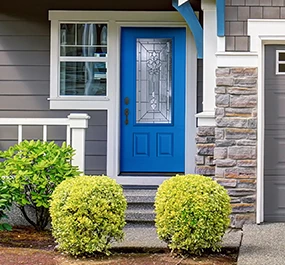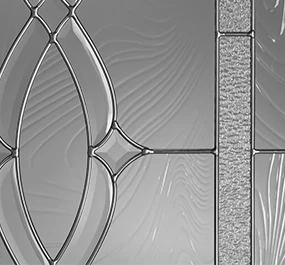Every property comes with its own unique set of challenges, and this includes choosing the right entry door for your unique situation. Safe, secure homes matter for everyone, and depending on the region you live in, this may require looking into a hurricane or impact resistant front door. Weather is beyond our control, but knowing local building codes and the options available can help us regain some power in protecting our families and homes.
Various regional building codes govern those who are located in hurricane prone regions, and impact doors, windows, and other accommodations may be both desirable and required. If you live in a “Wind-Borne Debris (WBD) Region” or “High Velocity Hurricane Zone (HVHZ),” or are planning a move there, you will naturally want to understand how an impact resistant front door can provide peace of mind and protect you and your loved ones. Always check your local building code first to ensure you have the most up-to-date, accurate information for your specific location.
The Difference Between WBD and HVHZ
Wind-Borne Debris Regions (WBD) and High Velocity Hurricane Zones (HVHZ) both require impact resistant front doors, and it’s important to understand how these labels differ, both from a regional perspective and a testing perspective
To understand these ratings, it’s important to know what is considered a “hurricane-prone region.” The International Building Code (IBC) defines these as “areas vulnerable to hurricanes,” including the Atlantic coast and Gulf of Mexico coast where the “basic design wind speed...is greater than 115 mph,” as well as Hawaii, Puerto Rico, Guam, Virgin Islands, and American Samoa.
Wind-Borne Debris Regions (WBD), then, are defined as areas within hurricane-prone regions that are located within one mile of the coast where the “basic design wind speed is 130 mph or greater,” or in areas where the “basic design wind speed is 140 mph or greater.”
High-Velocity Hurricane Zones (HVHZ), defined by the Florida Building Code, are specially designated areas (Florida’s Miami-Dade and Broward Counties) within Wind-Borne Debris Regions. Because of the higher wind speeds associated with these zones, an HVHZ-rating requires more stringent testing than a WBD-rating.
Impact Testing Requirements for WBD and HVHZ ratings
To achieve these ratings, impact resistant front doors must undergo a series of impact tests in addition to the standard building code testing. These tests include a water infiltration test, air infiltration test, cyclical test, and small and large missile tests. Doors are held to stricter standards to achieve the HVHZ rating.
The missile tests involve projectiles being fired at the door, simulating the effect of flying debris. For instance, the large-missile debris test requires doors to remain intact against the impact of 9-pound, 2”x4” pieces of lumber traveling at 34 MPH.
Small-missile debris testing is conducted by launching ten 2 gram steel balls at the glass at 50 MPH in three consecutive tests. For a door to meet the WBD impact standard, the 2”x4” lumber is allowed to penetrate the door, but the crack cannot be greater than 1/16” x 5”, and a 3” sphere cannot pass through the crack. For a door to meet the HVHZ standard, the 2”x4” lumber cannot penetrate the door at all, and in a subsequent air infiltration test, no air infiltration is allowed for an HVHZ door.
In addition to missile testing, the doors also undergo a cyclical test (also known as cycle test or pressure test). The door must withstand hurricane wind load pressure at the minimum of 9,000 cycles: 4,500 positive cycles and 4,500 negative cycles. This test is required for both WBD and HVHZ impact doors. The pressure test also determines a Design Pressure (DP) rating—a numerical value that represents the door’s ability to withstand a wind load. The higher the DP rating, the higher pressure a door can withstand.
A water infiltration test is also performed on the door unit. In the WBD impact test, the water infiltration test is performed independently, but in the HVHZ test it is performed alongside the pressure test. The greater the wind pressure that is put on the unit, the more water involved in the test. To achieve a HVHZ rating, not a single drop of water may pass over the sill on the inside of the home and reach the floor.
The benefits of installing impact-resistant front doors
To receive the benefits of this rigorous testing, look for an impact resistant front door. Outside the testing lab, regions prone to strong winds can fall victim to loose materials like trash cans, outdoor furniture, and debris as it’s carried through the air—as a result, windows or exterior doors can be damaged or broken. An added benefit of choosing an impact door is that the heavy-duty design also provides additional front door security, such as against break-ins.
In order to meet the testing criteria, impact doors are generally composed of reinforced doors skins and a specialized, high-density core. In addition, door unit components are also individually certified for impact use. This includes door jambs, door glass, and door locks. When it comes to glass, impact resistant front doors use laminated impact glass that can hold up against flying debris and high winds. Impact glass also provides other benefits as well, including increased home security and added protection against accidental damage. The glass is designed to stay in the frame and, while it can crack, it won’t shatter. In addition to security, impact resistant front doors provide many other benefits thanks to their design.
Energy Efficiency
Impact glass can also increase energy efficiency as today most impact glass comes with a LoE coating. LoE (low-emissivity) glass is coated with a material that reflects heat, with varying levels of insulation. LoE 366, the highest rating, provides a significant improvement in energy efficiency when compared to standard glass. Impact LoE glass is also available in lower ratings, such as LoE 272 or 180, to fit your specific needs and price point.
Soundproofing
Due to the layered construction and tight seals necessary to protect against severe weather, impact resistant front doors and glass typically perform better at blocking unwanted noise. These doors can help to maintain a quiet, comfortable home environment by keeping out noise such as traffic, lawnmowers, or outside conversation—and, of course, severe weather.
Insurance Cost
Impact resistant front doors have a lot of benefits for your home, but they can also save you money on insurance. Some insurance providers will decrease your monthly premium if your home features an impact door. Be sure to contact your provider before purchasing to ensure they offer the discount and that your door choice fits the deal.
Review local building codes
It’s important to keep up with your local building codes to ensure you know exactly what is needed in your area. The Florida Building Code was designed by the state of Florida, but it’s often used as a reference for hurricane-prone areas. The Florida Building Code and its list of approved products are important resources for navigating Wind-Borne Debris Regions and the sort of protection required in these areas.
That being said, certain areas of Texas have their own set of requirements. For these areas, consulting with the Texas Department of Insurance’s guidelines will be more applicable. As always, consulting with a professional is your best bet to understand exactly what your area requires.
Check out Plastpro’s HVHZ-rated Impact Door Series
Most of Plastpro’s standard doors are WBD-rated. This not only will ensure your door meets the requirements in Wind-Borne Debris Regions, but also will provide protection and security for your home, no matter where you are.
Plastpro also offers HVHZ impact doors that have a certified ability to hold up against hurricane-force wind speeds and debris in High Velocity Hurricane Zones. While all our doors come equipped with our unique HydroShield Technology, our solid HVHZ doors also offer a thicker skin and increased rigidity than our standard doors and other fiberglass doors on the market.
Other fiberglass manufacturers instead add a honeycombed steel door skin inside the foam of the door for their impact doors, but this can create issues with door shop tools when cutting these doors to accommodate impact glass inserts, as well as potential rust issues down the road. But the thickness of our HVHZ fiberglass skin combined with our HydroShield Technology allows these doors to meet and exceed the requisite codes and guidelines nationwide, without compromising any aesthetic value. Plastpro’s HVHZ impact doors come in a variety of styles, allowing you to find the perfect combination of beauty and security.
Combine these doors with Plastpro’s Polyfiber (PF) Door Frames for maximum protection. These frames are excellent in severe weather conditions due to their unique formula of weatherproof, composite material, and they are a Florida Building Code (FLBC) certified impact component. They also provide additional structural support (with a continuous design and twice the screw-holding power of wood frames).
Check out Plastpro’s Where to Buy page to find the closest distributor for our HVHZ Impact Series. For more information on our fiberglass door offerings, visit our website.



